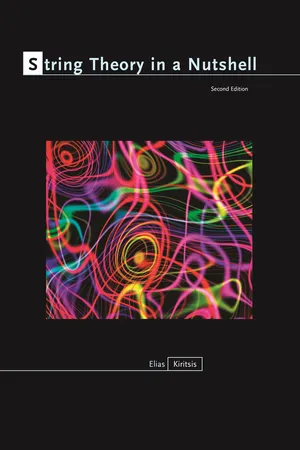
- English
- PDF
- Available on iOS & Android
About this book
The essential introduction to modern string theory—now fully expanded and revised
String Theory in a Nutshell is the definitive introduction to modern string theory. Written by one of the world's leading authorities on the subject, this concise and accessible book starts with basic definitions and guides readers from classic topics to the most exciting frontiers of research today. It covers perturbative string theory, the unity of string interactions, black holes and their microscopic entropy, the AdS/CFT correspondence and its applications, matrix model tools for string theory, and more. It also includes 600 exercises and serves as a self-contained guide to the literature.
This fully updated edition features an entirely new chapter on flux compactifications in string theory, and the chapter on AdS/CFT has been substantially expanded by adding many applications to diverse topics. In addition, the discussion of conformal field theory has been extensively revised to make it more student-friendly.
- The essential one-volume reference for students and researchers in theoretical high-energy physics
- Now fully expanded and revised
- Provides expanded coverage of AdS/CFT and its applications, namely the holographic renormalization group, holographic theories for Yang-Mills and QCD, nonequilibrium thermal physics, finite density physics, and entanglement entropy
- Ideal for mathematicians and physicists specializing in theoretical cosmology, QCD, and novel approaches to condensed matter systems
- An online illustration package is available to professors
Frequently asked questions
- Essential is ideal for learners and professionals who enjoy exploring a wide range of subjects. Access the Essential Library with 800,000+ trusted titles and best-sellers across business, personal growth, and the humanities. Includes unlimited reading time and Standard Read Aloud voice.
- Complete: Perfect for advanced learners and researchers needing full, unrestricted access. Unlock 1.4M+ books across hundreds of subjects, including academic and specialized titles. The Complete Plan also includes advanced features like Premium Read Aloud and Research Assistant.
Please note we cannot support devices running on iOS 13 and Android 7 or earlier. Learn more about using the app.
Information

Table of contents
- Cover
- Contents
- Preface to the Second Edition
- Preface to the First Edition
- Abbreviations
- 1. Introduction
- 2. Classical String Theory
- 3. Quantization of Bosonic Strings
- 4. Conformal Field Theory
- 5. Scattering Amplitudes and Vertex Operators
- 6. Strings in Background Fields
- 7. Superstrings and Supersymmetry
- 8. D-Branes
- 9. Compactification and Supersymmetry Breaking
- 10. Loop Corrections to String Effective Couplings
- 11. Duality Connections and Nonperturbative Effects
- 12. Compactifications with Fluxes
- 13. Black Holes and Entropy in String Theory
- 14. The Bulk/Boundary (Holographic) Correspondence
- 15. Applications of the Holographic Correspondence
- 16. String Theory and Matrix Models
- Appendixes
- Bibliography
- Index